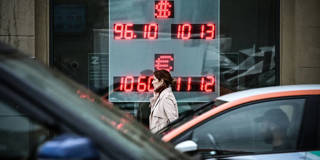While there is no reason to think that Russia’s economy is on the brink of collapse, the ruble's recent depreciation has highlighted just how much pressure the war – and the sanctions imposed in response to it – has placed on Russia’s economy. Now, the West must go even further.
PARIS – Within days of Russian President Vladimir Putin’s full-scale invasion of Ukraine 18 months ago, the West imposed unprecedented sanctions on Russia’s central bank, freezing hundreds of billions of dollars of its assets. The ruble plummeted, reaching a record low of 136 to the US dollar a week after the invasion. But after the central bank imposed currency and capital controls, the ruble bounced back, strengthening to ₽51.5/dollar – a recovery that the Kremlin eagerly touted.
Russia’s leaders have less to celebrate today. The ruble exchange rate offers the most visible indication of Russia’s economic performance, at least for Russian households. So, the currency’s recent dip below the politically important threshold of ₽100/dollar has made the Kremlin nervous. And it has put the central bank – which, over the last year, has loosened or removed many of its capital controls – under fire.
Putin’s economic aide, Maxim Oreshkin, has usually criticized the central bank for being overly hawkish. But after the ruble’s latest tumble, he wrote an op-ed blaming policymakers for being too “soft” and allowing excessive credit growth. The central bank immediately called an extraordinary board meeting, where it decided to hike interest rates by a whopping 3.5 percentage points, and signaled that more hikes are likely to come as early as next month. Additional currency controls also appear to be on the table. Meanwhile, Finance Minister Anton Siluanov reportedly advocates forcing Russian exporters to repatriate their dollar revenues and sell them to the central bank.

PARIS – Within days of Russian President Vladimir Putin’s full-scale invasion of Ukraine 18 months ago, the West imposed unprecedented sanctions on Russia’s central bank, freezing hundreds of billions of dollars of its assets. The ruble plummeted, reaching a record low of 136 to the US dollar a week after the invasion. But after the central bank imposed currency and capital controls, the ruble bounced back, strengthening to ₽51.5/dollar – a recovery that the Kremlin eagerly touted.
Russia’s leaders have less to celebrate today. The ruble exchange rate offers the most visible indication of Russia’s economic performance, at least for Russian households. So, the currency’s recent dip below the politically important threshold of ₽100/dollar has made the Kremlin nervous. And it has put the central bank – which, over the last year, has loosened or removed many of its capital controls – under fire.
Putin’s economic aide, Maxim Oreshkin, has usually criticized the central bank for being overly hawkish. But after the ruble’s latest tumble, he wrote an op-ed blaming policymakers for being too “soft” and allowing excessive credit growth. The central bank immediately called an extraordinary board meeting, where it decided to hike interest rates by a whopping 3.5 percentage points, and signaled that more hikes are likely to come as early as next month. Additional currency controls also appear to be on the table. Meanwhile, Finance Minister Anton Siluanov reportedly advocates forcing Russian exporters to repatriate their dollar revenues and sell them to the central bank.